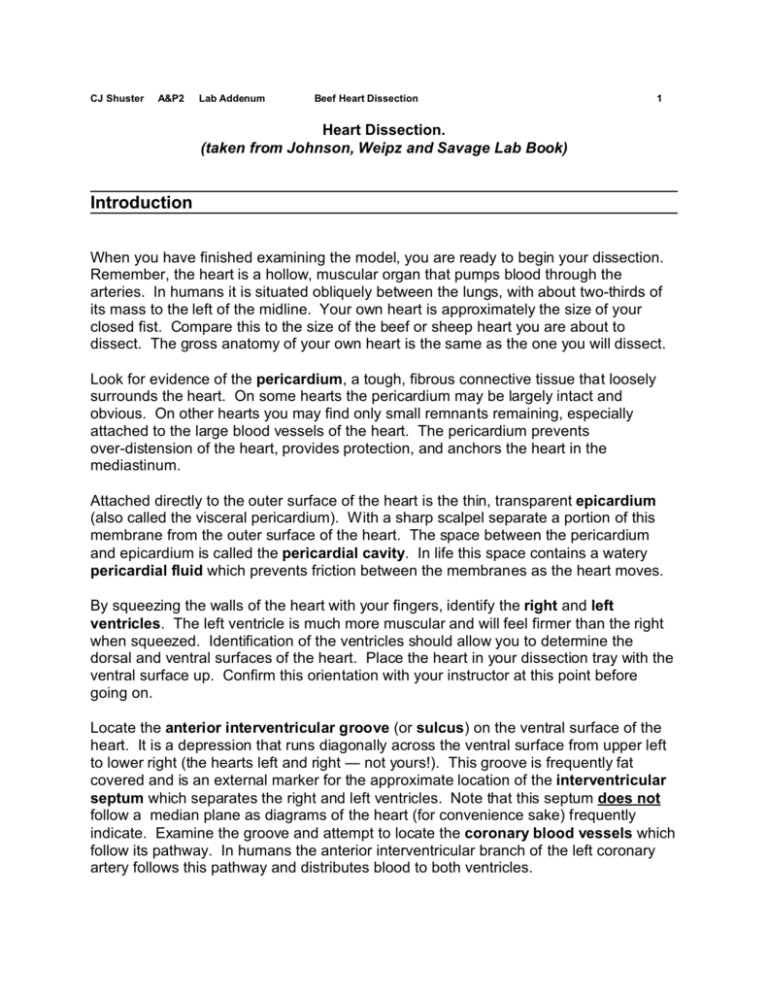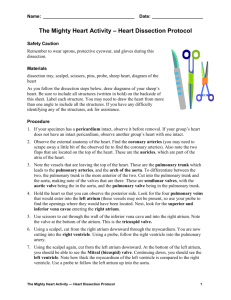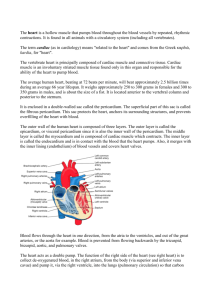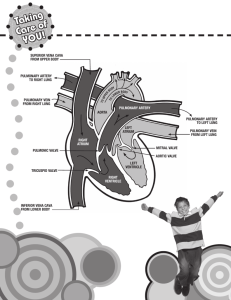Heart Dissection Handout
advertisement

CJ Shuster A&P2 Lab Addenum Beef Heart Dissection 1 Heart Dissection. (taken from Johnson, Weipz and Savage Lab Book) Introduction When you have finished examining the model, you are ready to begin your dissection. Remember, the heart is a hollow, muscular organ that pumps blood through the arteries. In humans it is situated obliquely between the lungs, with about two-thirds of its mass to the left of the midline. Your own heart is approximately the size of your closed fist. Compare this to the size of the beef or sheep heart you are about to dissect. The gross anatomy of your own heart is the same as the one you will dissect. Look for evidence of the pericardium, a tough, fibrous connective tissue that loosely surrounds the heart. On some hearts the pericardium may be largely intact and obvious. On other hearts you may find only small remnants remaining, especially attached to the large blood vessels of the heart. The pericardium prevents over-distension of the heart, provides protection, and anchors the heart in the mediastinum. Attached directly to the outer surface of the heart is the thin, transparent epicardium (also called the visceral pericardium). With a sharp scalpel separate a portion of this membrane from the outer surface of the heart. The space between the pericardium and epicardium is called the pericardial cavity. In life this space contains a watery pericardial fluid which prevents friction between the membranes as the heart moves. By squeezing the walls of the heart with your fingers, identify the right and left ventricles. The left ventricle is much more muscular and will feel firmer than the right when squeezed. Identification of the ventricles should allow you to determine the dorsal and ventral surfaces of the heart. Place the heart in your dissection tray with the ventral surface up. Confirm this orientation with your instructor at this point before going on. Locate the anterior interventricular groove (or sulcus) on the ventral surface of the heart. It is a depression that runs diagonally across the ventral surface from upper left to lower right (the hearts left and right — not yours!). This groove is frequently fat covered and is an external marker for the approximate location of the interventricular septum which separates the right and left ventricles. Note that this septum does not follow a median plane as diagrams of the heart (for convenience sake) frequently indicate. Examine the groove and attempt to locate the coronary blood vessels which follow its pathway. In humans the anterior interventricular branch of the left coronary artery follows this pathway and distributes blood to both ventricles. CJ Shuster A&P2 Lab Addenum Beef Heart Dissection 2 CJ Shuster A&P2 Lab Addenum Beef Heart Dissection 3 Locate the thin-walled right and left atria of the heart. These two chambers are much less muscular and look very different and distinct from the ventricles. Check with your classmates and/or instructor at this point to be sure you have accurately identified the atria. Each atrium has an appendage-like portion called an auricle. From a ventral view the two atria appear to be widely separated. In reality, however, they are separated by only a thin interatrial septum. If you follow the atria around the dorsal side of the heart, their close proximity to one another will be more obvious. CJ Shuster A&P2 Lab Addenum Beef Heart Dissection 4 Locate and identify the major blood vessels of the heart, including: NOTE: If you are dissecting a fresh heart, it was probably removed from the animal by someone who knew little about heart anatomy and who may not have been aware the heart was intended for dissection. Parts of the heart itself may be missing, as may be parts (and in some cases, even all) of various major vessels. Check with your instructor about vessels you are uncertain of or can't locate at all. If other hearts are being dissected, check to see if they show vessels that the heart you are working on does not. 1. Pulmonary Trunk — This vessel makes an anterior and medial exit from the right ventricle. It is large and muscular. Very shortly after its origin it curves dorsally and subdivides into right and left pulmonary arteries supplying the lungs. Fatty and connective tissues, including remnants of the pericardium, will have to be dissected away to get a clear view of this and other major vessels. 2. Aorta — This vessel makes an anterior and medial exit from the left ventricle. It is large and muscular. The origin is dorsal to (i.e., behind) the pulmonary trunk and will not be immediately obvious. What will be immediately obvious is the aortic arch which curls over the pulmonary trunk. Try to separate the aorta from the pulmonary enough to make them distinct. 3. Brachiocephalic (Innominate) Artery — a large branch of the aorta, located at the beginning of the aortic arch, which leads towards the head and shoulder regions. 4. Superior and Inferior Vena Cava — These vessels lead into the right atrium. They are large in diameter, but very thin-walled and collapsible compared to the arteries. You will have to insert your finger into them to keep them open and follow their pathway into the atrium. Make sure you see at least one of these. 5. Pulmonary Veins — These vessels lead into the left atrium. They are thin-walled and collapsible like the vena cava, but smaller in diameter. There are 4 of them, 2 from the right lungs and 2 from the left. 6. Ligamentum Arteriosum — a fibrous band between the pulmonary artery and the aorta which is a remnant of the ductus arteriosus that functions in fetal circulation. Ask your instructor if you should attempt to find this structure. CJ Shuster A&P2 Lab Addenum Beef Heart Dissection 5 CJ Shuster A&P2 Lab Addenum Beef Heart Dissection 6 CJ Shuster A&P2 Lab Addenum Beef Heart Dissection 7 CJ Shuster A&P2 Lab Addenum Beef Heart Dissection 8 CJ Shuster A&P2 Lab Addenum Beef Heart Dissection 9 Return to the superior vena cava. Insert the pointed blade of your scissors into the open end of this vessel and cut through it. Continue cutting down and into the right atrium, stopping short of the ventricle. This cut should have exposed the cusps of the tricuspid valve, between the right atrium and right ventricle. Continue your previous cut with the scissors from the right atrium through the tricuspid valve down to the apex of the heart. Examine the inside wall of the right atrium. The inner surface has ridges giving it a comb-like appearance; thus, it is called pectinate muscle. Between the inferior vena cava and the tricuspid valve you should see the opening to the coronary sinus. It is through this opening that the blood of the coronary circulation is returned to the venous circulation. Insert the probe under the cusps of the tricuspid valve. Are you able to see three separate cusps? Note the thickness of the muscle wall of the right ventricle. Note the interventricular septum. Locate the papillary muscles and chordae tendineae. How many papillary muscles do you see in the right ventricle? Identify the moderator band which is a reinforcement cord between the ventricular septum and the ventricular wall. Its presence prevents excessive stress from occurring in the myocardium of the right ventricle. With scissors make an incision through the right ventricular wall, parallel to the anterior interventricular groove, toward the pulmonary artery. Continue the cut into the pulmonary artery. Spread the cut surfaces of this new incision to expose the pulmonary semilunar valve. Study the semilunar valve with a probe. How many membranous pouches make up this valve? Use your scissors and/or scalpel to open the left atrium and left ventricle with cuts similar to the ones you made in the right heart. Compare the thickness of the muscle wall of the left ventricle to that of the right. Which ventricle creates higher blood pressures? Why is this important? Examine the bicuspid or mitral valve which lies between the left atrium and left ventricle. With a probe identify the two cusps. Examine the pouches of the aortic semilunar valve. Compare the structure and number of pouches of this valve with the pulmonary valve. Look for the two openings to the coronary arteries which are in the walls of the aorta just above the aortic semilunar valve. Force a blunt probe into each hole. Note that they lead into the coronary circulation of the myocardium. This completes the heart dissection. Check with your instructor about disposal of the heart tissue. CJ Shuster A&P2 Lab Addenum Beef Heart Dissection 10




